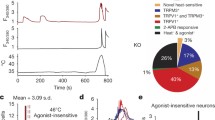Summary
Physiological variability was previously encountered while studying the effects of temperature on identified motorneurons. Of 22 locusts examined from within the breeding colony, 3 deviant animals were found in which the current threshold of the fast extensor tibiae (FETi) motorneuron did not decrease as was expected with increasing temperature (Fig. 1). We have used clones of isogenic locusts to study the genetic basis, physiological extent, and behavioral effects of a similar abnormal threshold response of FETi to increases in temperature.
Over 30 clones, raised by parthenogenetic breeding, were used to isolate naturally-occurring genotypic variability. In this study we have focused our attention on the behaviorally abnormal clone 7 animals that have a low probability of jumping which is not altered by heating; and the behaviorally normal clone 8 animals that have a higher probability of jumping which increases with increasing temperature (Table 1).
In clone 8 animals, the physiological properties of FETi show the normal steady-state responses to increases in temperature: the current threshold decreases (Fig. 1), the voltage threshold decreases, and the membrane resistance remains relatively unchanged.
In clone 7 animals, the physiological properties of FETi show abnormal steady-state responses to increases in temperature: the current threshold increases (Fig. 1), the voltage threshold remains relatively unchanged (Fig. 2), and the membrane resistance decreases (Fig. 3), all of which are similar to the abnormal responses observed occasionally from the heterogenic breeding colony. These abnormalities in FETi of clone 7 animals are regarded as a neurophysiological correlate of the absence of an increase in jumpiness with increasing temperature.
An abnormal response to heating in clone 7 animals is also found in AAdC (Fig. 6), ASFlTi, and the first basalar motorneuron. A normal response to heating in clone 7 animals is found in the spiracle closer motorneurons (Fig. 7), the DUM neurons, and the CI neuron.
Similar content being viewed by others
References
Alexander, R.D.: Evolutionary changes in cricket acoustical communication. Evolution16, 443–467 (1962)
Bate, C.M.: Embryogenesis of an insect nervous system. I. A map of the thoracic and abdominal neuroblasts inLocusta migratoria. J. Embryol. exp. Morph.35, 107–123 (1976)
Bentley, D.R.: Genetic control of an insect neuronal network. Science174, 1139–1141 (1971)
Bentley, D.R., Hoy, R.R.: Genetic control of the neuronal network generating cricket song patterns. Anim. Behav.20, 478–492 (1972)
Burrows, M.: Monosynaptic connections between wing stretch receptors and flight motorneurons of the locust. J. exp. Biol.62, 189–219 (1975a)
Burrows, M.: Co-ordinating interneurons of the locust which convey two patterns of motor commands: their connexions with flight motorneurons. J. exp. Biol.63, 713–733 (1975b)
Burrows, M.: Co-ordinating interneurons of the locust which convey two patterns of motor commands: their connexions with ventilatory motoneurons. J. exp. Biol.63, 735–753 (1975c)
Burrows, M., Horridge, G.A.: The organization of inputs to motoneurons of the locust metathoracic leg. Phil. Trans. B269, 49–94 (1974)
Burrows, M., Rowell, C.H.F.: Connections between descending visual interneurones and metathoracic motoneurones in the locust. J. comp. Physiol.85, 221–234 (1973)
Ewing, A.W., Manning, A.: The evolution and genetics of insect behavior. Ann. Rev. Entomol.12, 471–494 (1967)
Goodman, C.S.: Anatomy of locust ocellar interneurons: constancy and variability. J. comp. Physiol.95, 185–201 (1974)
Goodman, C.S.: Constancy and uniqueness in a large population of small interneurons. Science193, 502–504 (1976)
Hamilton, A.G.: Thelytokous parthenogenesis for four generations in the desert locust. Nature (Lond.)172, 1153–1154 (1953)
Heitler, W.J., Burrows, M.: The locust jump. II. Neural circuits of the motor programme. J. exp. Biol.66, 221–241 (1977)
Heitler, W.J., Goodman, C.S., Rowell, C.H.F.: The effects of temperature on the threshold of identified neurons in the locust. J. comp. Physiol.117, 163–182 (1977)
Hoy, R.: Genetic control of acoustic behavior in crickets. Amer. Zoologist14, 1067–1080 (1974)
Hoyle, G., Burrows, M.: Neural mechanisms underlying behavior in the locustSchistocerca gregaria. I. Physiology of identified motoneurons in the metathoracic ganglion. J. Neurobiol.4, 43–67 (1973)
Ikeda, K., Ozawa, S., Hagiwara, S.: Synaptic transmission reversibly conditioned by single-gene mutation inDrosophila melanogaster. Nature (Lond.)259, 489–491 (1976)
Levinthal, F., Macagno, E., Levinthal, C.: Anatomy and development of identified cells in isogenic organisms. Cold Spr. Harb. Symp. quant. Biol.40, 321–331 (1976)
Macagno, E.R., Lopresti, V., Levinthal, C.: Structure and development of neuronal connections in isogenic organisms: variations and similarities in the optic system ofDaphnia magna. Proc. nat. Acad. Sci. (Wash.)70, 51–61 (1973)
Manning, A.: The effects of artificial selection for mating speed inDrosophila melanogaster. Anim. Behav.9, 82–92 (1961)
Manning, A.: An introduction to animal behavior, 2nd ed. Reading, Mass.: Addison-Wesley (1972)
Ready, D.F., Hanson, T.E., Benzer, S.: Development of theDrosophila retina, a neurocrystalline lattice. Develop. Biol.53, 217–240 (1976)
Rowell, C.H.F.: The orthopteran descending movement detector (DMD) neurons: a characterization and review. Z. vergl. Physiol.73, 167–194 (1971)
Siddiqi, O., Benzer, S.: Neurophysiological defects in temperature-sensitive paralytic mutants ofDrosophila melanogaster. Proc. nat. Acad. Sci. (Wash.)73, 3253–3257 (1976)
Sulston, J.E.: Post-embryonic development in the ventral cord ofCaenorhabditis elegans. Phil. Trans. B275, 287–297 (1976)
Ward, S., Thomson, N., White, J.G., Brenner, S.: Electron microscopical reconstruction of the anterior sensory anatomy of the nematodeCaenorhabditis elegans. J. comp. Neurol.160, 313–338 (1975)
White, M.J.D.: Animal cytology and evolution, 2nd ed. Cambridge: Cambridge Univ. Press 1954
Willows, A.O.D., Dorsett, D.A.: Evolution of swimming behavior inTritonia and its neurophysiological correlates. J. comp. Physiol.100, 117–133 (1975)
Woollacott, M.H., Hoyle, G.: Membrane resistance changes associated with single, identified neuron learning. Soc. Neurosci.2, 339 (1976)
Uvarov, B.: Grasshoppers and locusts: a handbook of general acridology, Vol. 1. Cambridge: Cambridge Univ. Press 1966
Author information
Authors and Affiliations
Additional information
We thank Prof. C.H.F. Rowell, Dr. Ronald Calabrese, Prof. David Bentley, and David Heathcote for their suggestions and comments on the manuscript; and Prof. Keir Pearson for his helpful suggestions during the course of these experiments. Supported by NIH grant 09404-05 to C.H.F. Rowell and NSF predoctoral fellowship to C.S. Goodman.
Rights and permissions
About this article
Cite this article
Goodman, C.S., Heitler, W.J. Isogenic locusts and genetic variability in the effects of temperature on neuronal threshold. J. Comp. Physiol. 117, 183–207 (1977). https://doi.org/10.1007/BF00612786
Received:
Issue Date:
DOI: https://doi.org/10.1007/BF00612786




